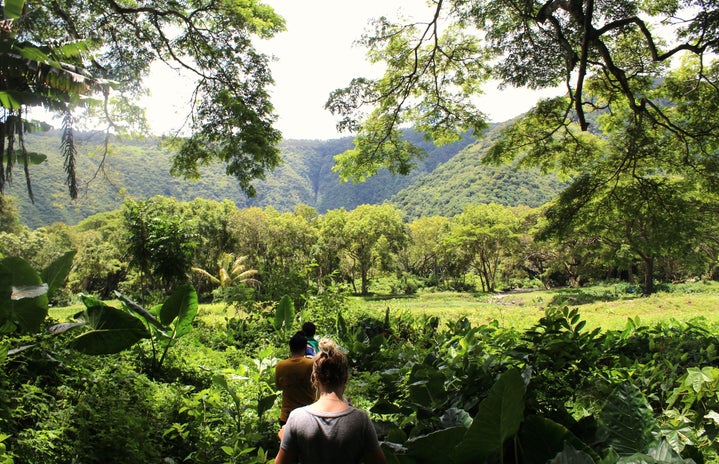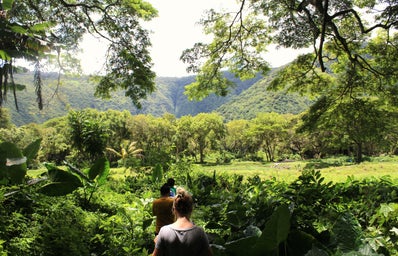The University of Hawai’i at Mānoa is nestled beautifully in the Mānoa valley on O’ahu, Hawai’i. Surrounding the campus is the Ko’olau mountain range close to Mānoa falls (a 150-foot waterfall), Diamond Head (a volcanic tuff cone, known as Lē’ahi) which can be seen from some dorms, and Waikiki, which is a short bus ride away. Anyways, enough of the scenery surrounding the campus.
Here are 7 special features of the UHM campus!
- echochamber
-
I know, this is super random but I think it’s such a unique thing to have on campus! Atop the main parking structure for the university is an echo chamber. If you stand in the center of the circle faced toward the ocean and speak out loud, you’ll hear an echo! This parking structure leads to the Stan Sheriff Center which hosts the university’s men’s and women’s basketball and volleyball events. After these events, you can hear the echos of drunk college students yelling into the abyss and running back to their dorms.
- buy a brick on legacy path
-
UH Mānoa gives students the option to leave their mark (literally) on campus with a personalized inscribed brick that will line the Legacy Path. This path begins after the crosswalk from the main parking structure and leads the way to campus center. Fun fact, the UHM Discord (UHMMFMRT) has a brick on the path too! Prices range from $250-$500 depending on where the brick is placed, with a maximum of 3 lines and 16 characters per line, letters are etched and filled with epoxy.
- A gift from thailand
-
This beautiful traditional pavilion (sala) is made of hard woods that are elaborately carved and painted in gold, built in Thailand and assembled here in Hawai’i. Their Majesties King Bhumibol Adulyadej and Queen Sirikit of Thailand donated the original in 1967, being one in four salas outside of Thailand bearing the Royal Seal. In 2006 the sala had to be reconstructed due to age and environmental conditions under the patronage of His Majesty. Students use the sala for picnics, studying, a pretty spot for instagram pics or a cool hangout spot in general to escape the harsh sun of Hawai’i.
- Korean studies building
-
This elaborate building houses the Center for Korean Studies, designed by both Korean and Hawaiian architects. Gyeongbokgung Palace (경복궁) in Seoul, South Korea provided the design inspiration for the buildings. Featuring distinct bright decorative colors and intricate designs of the tanch’ong (meaning red and blue) painting style. Throughout the two floors inside, a collection of art and artifacts are displayed showing the history of Korean culture. In early 2020 (when classes were still in person), walking into this building everyday for my Korean classes made me feel so special. Everyone who comes to campus can’t miss this awe-inspiring building. It feels as if a little piece of Korea is here on campus.
- a gift from japan
-
Dr. Genshitsu Sen, 15th generation grand tea master, generously donated the Jakuan Tea House in the 1970’s. This tea house was assembled in Japan, disassembled, and reassembled here in the East-West garden, featuring a garden and koi pond (designed by landscape architect Kenzo Ogata) adjacent to this tranquil gathering place. This space has since been used to study and perform the Urasenke-style tea ceremony. There are also events held here for students or the public to come and experience this serene tea ceremony of eating sweets (sometimes a whole meal too) and having a fresh cup of matcha tea.
- sculptures
-
Realistically, I can not write about all of the sculptures around campus because there are 43 in total (I’m not trying to write a novel here). However, I will write about the notable ones I’ve seen during my time here so far. The first sculpture I noticed when I came to campus was the “Gate of Hope” (Alexander Liberman, 1972) standing 30-feet high and painted bright orange-red referring to engineering principles allowing people to build complex structures. Traveling back to the main parking structure I mentioned earlier, before the crosswalk to Legacy Path, there is a bronze sculpture of three people conversing called “Chance Meeting” (George Segal, 1991). Signage of this sculpture shows the directions mauka (upland), makai (seaward), ‘Ewa (toward leeward plain) and Koko Head (toward the eastern volcano). On my walk every morning from the dorms to the Center for Korean Studies, next to Kennedy Theatre stood the Hawai’i Peace Memorial (Koji, 1986), a granite monument commemorating the Japanese immigration to Hawai’i. Lastly, Pulelehua (Robert Flint, 1986), a gigantic ceramic mural of a Kamehameha Butterfly (one of two native butterfly species in Hawai’i) welcoming students to the home of biological science laboratories and the entomology department.
- Nature
-
For my 7th and final special feature, I chose nature. This is Hawai’i after all! Seriously though, the UHM campus has an incredible collection of plants augmented by horticulturalists and botanists with more than 6,000 plants and over 700 species. The species vary on topics of aesthetic and ethic reasons for choosing which plants should be planted and where. Native plants, cultural heritage plants, and cosmopolitan plants contributing to ecological, relational and sensory aesthetics, along with moral, political, and universalist ethic reasonings for understanding the landscape values. Each plant seen on campus has signage describing what plant it is, where it comes from, and what it’s all about!


